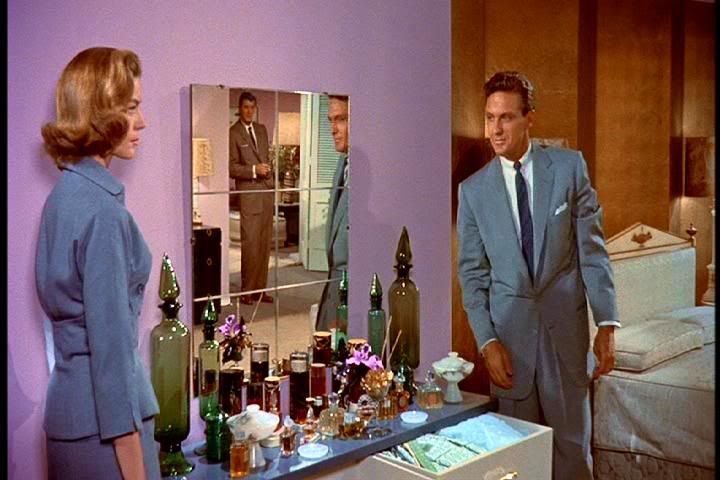
Douglas Sirk's Written on the Wind seethes with sexuality — or, more properly, with frustrated sexuality, with a sense of impotence, both literal and figurative. It's the story of a family of wealthy Texas oil barons, the Hadleys, and especially the alcoholic playboy heir Kyle (Robert Stack) and his wild, nymphomaniac sister Marylee (Dorothy Malone). Kyle, despite his wealth and privilege, has been shadowed all his life by feelings of inferiority, especially in comparison to his lifelong friend Mitch (Rock Hudson). And yet it's Kyle who winds up getting the girl, Lucy (Lauren Bacall), who's the object of both friends' affection, and when she marries Kyle after a whirlwind romance, it appears that his life has straightened out again. Kyle's happiness is destroyed, though, when he finds out that he is impotent, a blow that's like the literal, physical proof for a lifetime of feelings of inadequacy.
Sirk hilariously punctuates this scene, after Kyle storms out of a meeting with his doctor, with an image of a little boy happily riding a mechanical horse as Kyle passes by. And if the image of the bucking stallion wasn't obvious enough already, Kyle's tormented glance at the kid is enough to drive home the point. Sirk's mise en scène is frequently crammed with this kind of visual metaphor, as lurid and potent as the brightly ridiculous colors he decorates his sets with. Every inch of Written on the Wind is squirming with sublimated sexuality, right from the opening scene with its foreshadowing of violence, encapsulated by a phallic, bright yellow sports car and, of course, a pistol, up to the penultimate shot of Marylee suggestively caressing a model oil derrick as the man she loves walks away with another woman. The pistol, the oil derrick, the sports car, these stereotypically masculine symbols, are constants throughout the film, reminders of Kyle's insecurity and impotence, and Marylee's similar inability to get the one thing she really wants, which is Mitch.
It's Sirk's genius for such inventive mise en scène that characterizes this film. Every scene is as much about the setting as the characters in it, or, rather, the setting is used as a mirror image for the characters and their psychological states. And speaking of mirrors, Sirk puts them to good use as well, with mirrors constantly revealing the extra presence in the room, as in the screen capture above where the mirror places Mitch's reflection like an obstacle between the soon-to-be-formed couple of Kyle and Lucy. Kyle steps forward a moment later, his form blocking Mitch's reflection from out of the shot, and figuratively locking him away from Lucy as well. In another scene, when Marylee vindictively warns Lucy about her brother's philandering and drinking, Sirk sets up the shot over Lucy's shoulder, with Marylee's face framed by a small round vanity mirror. Sirk uses mirrors to suggest people who are both seen and unseen, as Marylee with her ignored advice or Mitch with his potentially disrupting effect on Kyle's budding romance with Lucy. Thus the mirrors suggest their presence in the scene without granting them a real physical presence — they are easily ignored or, as Kyle does to Mitch's reflection, covered up.
With Written on the Wind, it's easy to see why Sirk has had such a decisive influence on everyone from Godard to Fassbinder to Todd Haynes. The film's plot is simple, and the fact that Sirk reveals the climax right away during the credits proves that he's not interested in building any real suspense or telling a story. We know right from the start that things are going to go badly, but the emphasis of Sirk's film is not necessarily how things got there, the step by step process, but why these things happened. What interests him in this story are the characters, their psychological depths and relationships, and the ways in which the film's style can be used to reflect these things without being too explicit. The dialogue occasionally disappoints in this regard, giving the characters long-winded explanations of motivation that seem totally unnecessary in light of Sirk's gift for visual storytelling. When Marylee frankly explains that she sleeps around so freely out of frustration because she can't have Mitch, this was already entirely obvious from the scene in which Mitch "rescues" her from yet another sleazy guy, and Sirk cuts to numerous close-ups showing her facial expressions. But the periodic lapses into expositional dialogue are, in another sense, just another aspect of the deliberately awkward and artificial aesthetic of the film, of which the overblown dialogue and the lurid Technicolor designs are the most obvious examples. This is a fascinating, darkly funny, and constantly compelling melodrama, one built around internal frustrations and their sublimated external expressions, a true masterpiece of explosive Freudian angst.
what is the name of the yellow sports car in WRITTEN ON THE WIND?
ReplyDeleteThe yellow one that Robert Stack drives is a 1953 Allard J2X:
ReplyDeletehttp://www.colinsclassicauto.com/detail.php?car=375